Chandra Shumsher Jang Bahadur Rana
Field-Marshal Maharaja Sri Teen Chandra Shumsher Junga Bahadur Rana GCB GCSI GCMG GCVO FRGS (8 July 1863 – 26 November 1929) was the Prime Minister of Nepal from the Rana dynasty. He served in this capacity from 27 June 1901 to his death in 1929, after he successfully deposed his liberal and reformist brother Dev Shamsher. Although generally perceived as despotic and conservative, he is credited with several reforms including the abolition of slavery and the Nepal-Britain Treaty of 1923, which recognized Nepal as an independent nation and an ally of Britain.
Chandra Shamsher Jang Bahadur Rana, GCB, GCSI, GCMG, GCVO, FRGS | |
|---|---|
श्री ३ महाराज चन्द्र शमशेर जङ्गबहादुर राणा | |
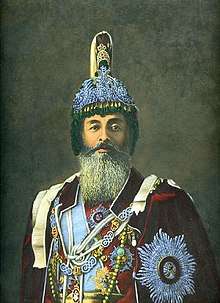 | |
| 13th Prime Minister of Nepal Sri 3 Maharaj of Kaski and Lamjung | |
| In office 27 June 1901 – 26 November 1929 | |
| Monarch | King Tribhuvan |
| Preceded by | Dev Shumsher |
| Succeeded by | Bhim Shumsher |
| Personal details | |
| Born | 8 July 1863 Kathmandu, Nepal |
| Died | 26 November 1929 (aged 66) Kathmandu, Nepal |
| Shree Teen Chandra Shamsher Jang Bahadur Rana श्री ३ महाराज चन्द्र शम्शेर जङ्गबहादुर राणा | |||||
|---|---|---|---|---|---|
| King of Lamjung and Kaski Kingdom His Highness Commanding General Svasti Sri Madati Prachandra Bhujadandyetyadi Sri Sri Sri Maharaja T'ung-ling-ping-ma-Kuo-Kang-Wang Knight Grand Cross of the Order of the Bath Knight Grand Commander of the Order of the Star of India Knight Grand Cross of the Royal Victorian Order Knight Grand Cross of the Order of St Michael and St George Fellow of the Royal Geographical Society | |||||
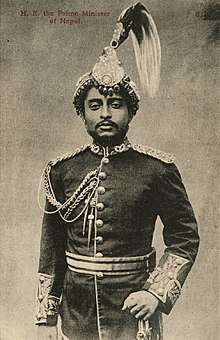 | |||||
| Reign | 27 June 1901 – 26 November 1929 | ||||
| Coronation | 27 June 1901 | ||||
| Predecessor | Dev Shumsher Jung Bahadur Rana | ||||
| Successor | Bhim Shumsher Jung Bahadur Rana | ||||
| Spouse | Sri 3 Maharani Chandra Loka Bhakta | ||||
| Issue | Mohan Shumsher Jung Bahadur Rana Baber Shamsher Jang Bahadur Rana Kaiser Shamsher Jang Bahadur Rana Singha Shamsher Jang Bahadur Rana Krishna Shamsher Jang Bahadur Rana | ||||
| |||||
| Dynasty | Rana dynasty | ||||
| Father | Dhir Shumsher Jang Bahadur Rana | ||||
| Mother | Nanda Kumari Thapa (Thapa dynasty) | ||||
Family and early life
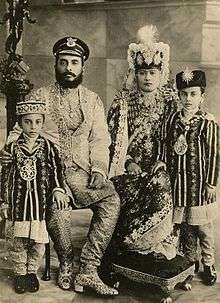
Chandra Shumsher was the sixth of the seventeen sons of Dhir Shumsher Rana (the youngest brother of Jung Bahadur Rana) through his Thapa wife Nanda Kumari, of whom he was the third son.[1] He was educated in Kolkata and thus became to be the first Nepalese Prime Minister who had passed matriculation examination. In the convocation address of 1884, the then Vice Chancellor of Calcutta University praised him as: "a gentleman who has shown he can handle pen as efficiently as sword."[2] Seto Bagh, a historical novel set on the early days of Chandra Shumsher, depicts him as an ambitious and cunning young man with an excellent command of the English language.[3]
Rise to power
He along with his brothers Khadga Shumsher and Bir Shamsher, orchestrated the murder of his uncle Sri Teen Maharaja Ranodip Singh in order to rise in the line of succession for the hereditary Rana Prime Minister of Nepal. After the demise of his eldest brother Bir Shamsher in March 1901, he became the Commander in Chief of the Nepalese Army under the premiership of his brother Dev Shamsher. Dev Shamsher, however, was a liberal and fearing the rise in public awareness and eventual democratisation that his short rule had brought, Chandra Shamsher orchestrated coup d'état and seized the power for himself in June 1901.[4] Although opposed to reforms and public education, he would later bring numerous reforms, most of them unwillingly, after his visit to Europe, as he found Nepal to be far more backwards than Europe.
In Chandra Shumsher's regime, Sardar RamMani Acharya Dixit was one of the mandarins to wield enormous influence by virtue of his proximity. Chandra used Ram Mani's native genius to keep the Mahila Gurujyu in check and ran the country with the advice of these two brilliant bahuns. With their help, Chandra amassed a fortune by making deals with the British over the recruitment of Gurkha soldiers and the mercenary services rendered by the Royal Nepali Army on the side of the British Empire.[5]
Rule
During the 28 years of his rule, Chandra Shumsher held the firm control of domestic as well as the foreign policy of Nepal. His ADC (Assistant Deputy Commissioner) was Nar Narayan Shah. He went to Britain under the guidance of his ADC. Nar Narayan Shah worked as ADC for 20 years.
After his return from the European tour, he is said to have been embarrassed by the backwardness of his country, so he executed some noteworthy reforms. He abolished Sati custom, and made it illegal for a person to be killed for witchcraft. He was counseled by Sardar RamMani Acharya Dixit, which further assured him to ban the ritual suicide, and make additional reforms such as abolishing slavery with the money from the treasury of Pashupatinath temple. He built the first college of Nepal, Tri-Chandra College in 1975 B.S. He established several canals in Terai region and established hospitals throughout Nepal. The first railway service in Nepal, Nepal Government Railway from Raxaul to Amlekhganj, started its service in his tenure. These reforms, however, were mostly brought for the benefit of his family.
He was the second Nepalese prime minister to visit Britain and tour Europe after Jung Bahadur Rana. In Britain, he stayed in Mortimer house and was entertained by His Majesty Edward VII. He also observed naval exercises of British Royal navy and in one of the warships, he met the French President under the arrangement of Edward VII. On 24 June, the University of Oxford conferred the honoris causa degree of Doctor of Civil Laws on him. On his departure, the Daily Telegraph wrote:
During the last few years this country has been visited by an unexampled succession of foreign personages, but none of them has been more interesting and few more important than the Prime Minister of Nepal.[2]
He provided monetary and military assistance to Britain in the First World War,[6] as a result of which Nepal received a huge sum of monetary assistance and the friendship became even more cordial after the successful conclusion of the Nepal–Britain Treaty of 1923, which recognised Nepal as an independent nation and an ally of the British Empire.[7]
Legacy
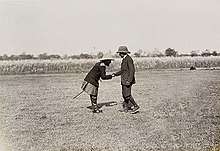
Chandra Shamsher suffered with tuberculosis and followed a strict diet regimen of rice and black lentils exclusively, as a result he was extremely thin and is sometimes called "Phistey Maharaj". A popular quote "चन्द्रे हाँस्यो त नास्यो" suggests that he seldom laughed and his laughter was rather an ominous one. He abolished Sati custom and slavery from Nepal. TriChandra Campus, Tribhuwan Chandra Military Hospital, Chandra Jyoti Hydro Power at Pharping still bears his name as he established them. Singha Durbar, then the largest palace in Asia with over 1200 rooms, was built by him. Chandra Nahar, the oldest canal of Nepal located in Saptari, was built by him as well. The city of Chandranigahpur in Rautahat district was named after him.
Descendants
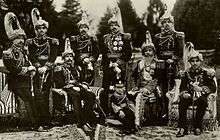
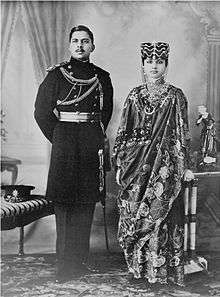
Chandra Shamsher's descendants are still among the most prominent members of the Rana family. They are scattered all over princely states of the Indian subcontinent. Since Chandra Shamsher ruled Nepal for a period of 28 years and had the exclusive control of the national economy, he accumulated immense wealth and built lavish palaces for his sons. His descendants are the richest in all of the Rana dynasty.[8]
Given below is the list of Chandra Shamsher's children:
- Khagaraja Divyeshwari Rajya Laxmi (1880–19?), married to Raja Jai Prithvi Bahadur Singh of Bajhang.
- Field-Marshal Mohan Shamsher, GCB, GCIE, GBE, (23 December 1885 – 6 January 1967) who succeeded to the title of the 9th Rana Prime Minister of Nepal. The century-old family oligarchy of the Ranas came to an end during the reign of Mohan Shamsher.
- Commanding General HH Sir Baber Shamsher Jang Bahadur Rana, GCVO, GBE, KCSI, KCIE (27 January 1888 – 12 May 1960), desc. Senior Rana during the Mohan Shamsher premiership, Sir Baber was the Mukthiyar and Commander-in-Chief of the Royal Nepalese Army.[9] Minister of Defence in the Congress Rana Cabinet.
- Field-Marshal HH Sir Kaiser Shamsher Jang Bahadur Rana, GBE (8 January 1892 – 7 June 1964), desc. Married Lakshmi Rajya Lakshmi, the then heir apparent of king Prithvi of Nepal.
- Commanding General HH Singha Shamsher Jang Bahadur Rana, KBE (23 December 1893 – 19?), desc. He was the Ambassador to India (1948–1951).
- Commanding General Krishna Shamsher Jang Bahadur Rana, KCSI, KBE (28 February 1900 – 19 May 1977), desc. In 1909, he married Princess Tara Rajya Laxmi Devi, the third daughter of King Prithvi of Nepal. He died in Bangalore, India in 1977.
- Major-General Vishnu Shamsher Jang Bahadur Rana (13 November 1906 – 4 February 1946). Exiled, died in the Bahamas having had one son - Rajkumar Pitamber Shamsher Jang Bahadur Rana (1931–2005). Removed from the line of succession.
- General Shanker Shamsher Jang Bahadur Rana, GBE (1909 – 4 June 1976), desc. Nepal's Representative to the Court of St. James.
- Lt.-Gen. Madan Shumsher Jang Bahadur Rana (1909–1955), desc.
- Khagaraja Divyeshwari Rajya Laxmi (1918–1999), desc.
- Major-General Maharajkumar Badri Shumsher Jung Bahadur Rana, desc.
Titles and styles
- 8 July 1863 – 1877: His Excellency Chandra Shamsher Kunwar Rana
- 1877 – 1878: His Excellency Chandra Shamsher Kunwar Rana
- 1878 – 1882: Lieutenant-Colonel His Excellency Chandra Shamsher Kunwar Rana
- 1882 – 1885: Major-General His Excellency Chandra Shamsher Kunwar Rana
- 1885 – 1901: Commanding General His Excellency Chandra Shamsher Jang Bahadur Rana
- 1901 – 1 January 1905: Commanding General His Excellency Svasti Sri Madati Prachandra Bhujadandyetyadi Ati-Projjwala-Nepal-Taradisha Sri Teen Maharaja Chandra Shamsher Jang Bahadur Rana, Maharaja of Lamjung and Kaski
- 1 January – 10 June 1905: Commanding General His Excellency Svasti Sri Madati Prachandra Bhujadandyetyadi Ati-Projjwala-Nepal-Taradisha Sri Teen Maharaja Chandra Shamsher Jang Bahadur Rana, Maharaja of Lamjung and Kaski, GCSI
- 10 June 1905 – 1911: Commanding General His Excellency Svasti Sri Madati Prachandra Bhujadandyetyadi Ati-Projjwala-Nepal-Taradisha Sri Teen Maharaja Chandra Shamsher Jang Bahadur Rana, Maharaja of Lamjung and Kaski, GCB, GCSI
- 1911 – 1919: Commanding General His Excellency Svasti Sri Madati Prachandra Bhujadandyetyadi Ati-Projjwala-Nepal-Taradisha Sri Teen Maharaja Chandra Shamsher Jang Bahadur Rana, Maharaja of Lamjung and Kaski, GCB, GCSI, GCVO, FRGS
- 1919 – 1920: Commanding General His Excellency Svasti Sri Madati Prachandra Bhujadandyetyadi Ati-Projjwala-Nepal-Taradisha Sri Teen Maharaja Chandra Shamsher Jang Bahadur Rana, Maharaja of Lamjung and Kaski, GCB, GCSI, GCMG, GCVO, FRGS
- 1920 – 1926: Commanding General His Highness Svasti Sri Madati Prachandra Bhujadandyetyadi Ati-Projjwala-Nepal-Taradisha Sri Teen Maharaja Chandra Shamsher Jang Bahadur Rana, Maharaja of Lamjung and Kaski, GCB, GCSI, GCMG, GCVO, FRGS
- 1926 – 26 November 1929: Field Marshal His Highness Svasti Sri Madati Prachandra Bhujadandyetyadi Ati-Projjwala-Nepal-Taradisha Sri Teen Maharaja Chandra Shamsher Jang Bahadur Rana, Maharaja of Lamjung and Kaski, GCB, GCSI, GCMG, GCVO, FRGS
Honours

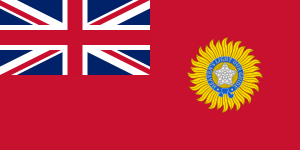
.svg.png)







Ancestry
| Ancestors of Chandra Shumsher Jang Bahadur Rana | |||||||||||||||||||||||||||||||||||||||||||||||||||||||||||||||||||||||||||||||||||||||||||||||||||||||||||||||||||||||||||||||||||||||||||||||||||||||||||||||||||||||||||||||||||||||||||||||||||||||||||||||||||||||||||||||||||||||||||||||||||||||||||||||||||||||||||||||||||||||||||||||||||||||||||||||||||||||||||||||||||||||||||||||||||||||||||||||||||||||||||||||||||||||||||||||||||||||||||||||||||||||||||||||||||||||||||||||||||||||||||||||||||||||||||||||||||
|---|---|---|---|---|---|---|---|---|---|---|---|---|---|---|---|---|---|---|---|---|---|---|---|---|---|---|---|---|---|---|---|---|---|---|---|---|---|---|---|---|---|---|---|---|---|---|---|---|---|---|---|---|---|---|---|---|---|---|---|---|---|---|---|---|---|---|---|---|---|---|---|---|---|---|---|---|---|---|---|---|---|---|---|---|---|---|---|---|---|---|---|---|---|---|---|---|---|---|---|---|---|---|---|---|---|---|---|---|---|---|---|---|---|---|---|---|---|---|---|---|---|---|---|---|---|---|---|---|---|---|---|---|---|---|---|---|---|---|---|---|---|---|---|---|---|---|---|---|---|---|---|---|---|---|---|---|---|---|---|---|---|---|---|---|---|---|---|---|---|---|---|---|---|---|---|---|---|---|---|---|---|---|---|---|---|---|---|---|---|---|---|---|---|---|---|---|---|---|---|---|---|---|---|---|---|---|---|---|---|---|---|---|---|---|---|---|---|---|---|---|---|---|---|---|---|---|---|---|---|---|---|---|---|---|---|---|---|---|---|---|---|---|---|---|---|---|---|---|---|---|---|---|---|---|---|---|---|---|---|---|---|---|---|---|---|---|---|---|---|---|---|---|---|---|---|---|---|---|---|---|---|---|---|---|---|---|---|---|---|---|---|---|---|---|---|---|---|---|---|---|---|---|---|---|---|---|---|---|---|---|---|---|---|---|---|---|---|---|---|---|---|---|---|---|---|---|---|---|---|---|---|---|---|---|---|---|---|---|---|---|---|---|---|---|---|---|---|---|---|---|---|---|---|---|---|---|---|---|---|---|---|---|---|---|---|---|---|---|---|---|---|---|---|---|---|---|---|---|---|---|---|---|---|---|---|---|---|---|---|---|---|---|---|---|---|---|---|---|---|---|---|---|---|---|---|---|---|---|---|---|---|---|---|---|---|---|---|---|---|---|---|---|---|---|---|---|---|---|---|---|---|---|---|---|---|---|---|---|---|---|---|---|---|---|---|---|---|---|---|---|---|---|---|---|---|---|---|---|---|---|---|---|---|---|---|---|---|
| |||||||||||||||||||||||||||||||||||||||||||||||||||||||||||||||||||||||||||||||||||||||||||||||||||||||||||||||||||||||||||||||||||||||||||||||||||||||||||||||||||||||||||||||||||||||||||||||||||||||||||||||||||||||||||||||||||||||||||||||||||||||||||||||||||||||||||||||||||||||||||||||||||||||||||||||||||||||||||||||||||||||||||||||||||||||||||||||||||||||||||||||||||||||||||||||||||||||||||||||||||||||||||||||||||||||||||||||||||||||||||||||||||||||||||||||||||
References
- JBR, PurushottamShamsher (1990). Shree Teen Haruko Tathya Britanta (in Nepali). Bhotahity, Kathmandu: Vidarthi Pustak Bhandar. ISBN 99933-39-91-1.
- Vadivelu, A. The Ruling Chiefs, Nobles and Zamindars of India. Second Line Beach, Madras: G.C. Loganadam Bros.
- Jang Bahadur Rana, Diamond Shumsher. Seto Bagh. Sajha Prakashan.
- Upadhyay, Shreeram Prasad. Active Social Studies. Bagbazaar, Kathmandu: Koselee Prakashan.
- "Last of the mandarins". nepalitimes.com.
- Joshi, Bhuwan Lal; Rose, Leo E. (17 December 1966). "Democratic Innovations in Nepal: A Case Study of Political Acculturation". University of California Press – via Google Books.
- Hussain, Assad (1970). British India's relation with the Kingdom of Nepal. London: George Allen and Unwin Ltd. p. 208.
- Sapkota, Janak Raj (1 January 2012). "Sahi Saan" (Vol.12 No.20). Nepal magazine Kantipur Publications.
- "30,000 Gurkhas solve a problem". 23 November 1950. p. 2 – via Trove.
External link
![]()
